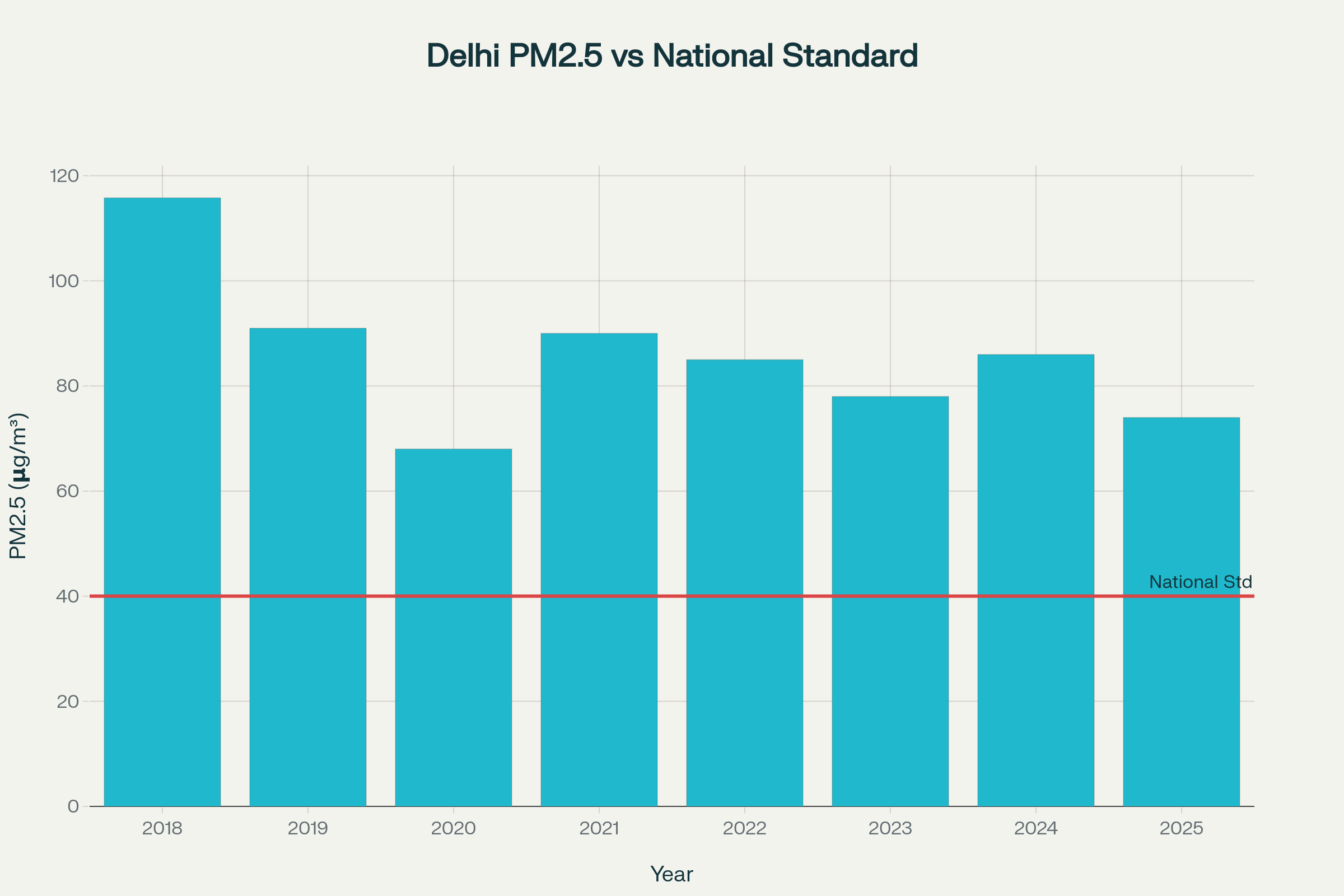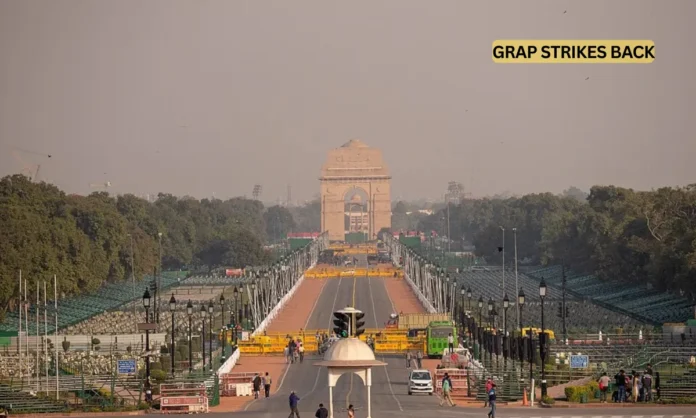Key Highlights:
- Delhi Air Pollution Crisis reaches critical point with AQI hitting 211, triggering first seasonal GRAP-1 enforcement on October 14, 2025
- Multiple monitoring stations record ‘Very Poor’ air quality with five locations exceeding AQI 300 threshold
- Commission for Air Quality Management activates comprehensive 27-point action plan across entire NCR region
The Delhi Air Pollution Crisis has officially begun for the 2025-26 winter season as the Commission for Air Quality Management (CAQM) implemented Stage-1 restrictions under the Graded Response Action Plan on October 14, 2025. The capital’s Air Quality Index deteriorated to 211, marking the first ‘Poor’ category reading since June and triggering immediate enforcement of anti-pollution measures across the National Capital Region.
This Delhi Air Pollution Crisis escalation comes earlier than historical patterns, with five monitoring stations recording ‘Very Poor’ conditions exceeding AQI 300 by October 15, including Anand Vihar at 345, DU North Campus at 307, and Wazirpur at 325. The CAQM’s decision followed comprehensive analysis of real-time data from the Central Pollution Control Board and meteorological forecasts indicating sustained poor air quality conditions through mid-October.
Comprehensive GRAP Stage-1 Framework Addressing Delhi Air Pollution Crisis
The current Delhi Air Pollution Crisis response involves implementing 27 specific preventive measures targeting construction dust control, vehicular emissions, industrial monitoring, and waste management across Delhi and adjoining NCR districts in Uttar Pradesh, Haryana, Rajasthan, and Punjab. These restrictions represent the most comprehensive early-season intervention in recent years, addressing primary pollution sources before the traditional post-Diwali surge.
- Construction sites exceeding 500 square meters require mandatory dust mitigation plans and water sprinkling systems
- Heavy vehicles face enhanced black carbon emission audits with immediate compliance requirements
- Power plants within 10 kilometers of Delhi must operate exclusively on piped natural gas
- Complete prohibition of garbage burning activities with intensified biomedical waste protocols
The Delhi Air Pollution Crisis management strategy focuses particularly on construction activities, which contribute significantly to particulate matter levels during pre-winter conditions. Enhanced road cleaning through mechanized sweeping, scientific dust disposal, and mandatory pollution control system functionality checks for industries form core components of the current intervention.
Critical Air Quality Data Revealing Delhi Air Pollution Crisis Severity
Official Central Pollution Control Board data confirms the Delhi Air Pollution Crisis has intensified with the capital’s AQI reaching 233 by October 15, 2025, while maintaining its position in the ‘Poor’ category with forecasts predicting further deterioration. Current monitoring across 37 stations reveals PM2.5 and PM10 as dominant pollutants, with ozone contributing to overall air quality degradation.ews.
| Station Name | Location | Current AQI | Category | Primary Pollutant |
|---|---|---|---|---|
| Anand Vihar | East Delhi | 345 | Very Poor | PM2.5 |
| DU North Campus | North Delhi | 307 | Very Poor | PM10 |
| Wazirpur | North Delhi | 325 | Very Poor | PM2.5 |
| Rohini | North West Delhi | 289 | Poor | PM10 |
| RK Puram | South West Delhi | 256 | Poor | PM2.5 |
The Delhi Air Pollution Crisis monitoring reveals concerning trends with real-time data showing sustained elevation in particulate matter concentrations across the region. Despite favorable meteorological conditions during August 2025, when Delhi recorded its best average AQI of 89 in recent years, the current deterioration indicates the seasonal transition towards winter pollution patterns.

Delhi’s PM2.5 pollution levels compared to national standards from 2018-2025, showing significant improvement despite remaining above safe limits
Historical Context and Long-term Delhi Air Pollution Crisis Trends
The current Delhi Air Pollution Crisis occurs within a broader context of gradual air quality improvements over recent years, with 2025 showing the capital’s best January-August average AQI of 172 since 2018, excluding the pandemic year 2020. However, recent data indicates concerning reversals, with annual PM2.5 levels rising to 104.7 µg/m³ in 2024, representing a 3.4 percent increase from 2023 levels.
The Delhi Air Pollution Crisis typically intensifies post-Diwali, with historical data showing the capital experiencing over 50 ‘Severe’ air quality days during the 2024-25 winter season. Current forecasting models from the Indian Institute of Tropical Meteorology, which maintain over 80 percent accuracy in predicting ‘Very Poor’ episodes, project potential AQI escalation to 250+ by month-end due to calm winds and clear skies trapping pollutants.
Expert analysis highlights the Delhi Air Pollution Crisis extends beyond seasonal variations, with Dr. Anumita Roychowdhury from the Centre for Science and Environment noting that despite a 71.2 percent reduction in stubble burning incidents during October-December 2024, winter pollution remained elevated. This indicates local and regional pollution sources including vehicles, industries, waste burning, and construction activities have offset previous gains.
Immediate Health and Economic Implications of Delhi Air Pollution Crisis
The escalating Delhi Air Pollution Crisis poses immediate health risks with current PM2.5 concentrations at monitoring stations reaching levels 2.6 times higher than the national ambient air quality standard of 40 µg/m³. The crisis particularly affects vulnerable populations during evening hours when pollutant concentrations typically peak due to reduced atmospheric mixing.
Citizens are urged to follow GRAP Stage-1 guidelines including using public transportation, avoiding outdoor physical activities during peak pollution hours, and reporting violations through CAQM’s dedicated helpline 1800-180-1708. The Delhi Air Pollution Crisis economic impact mirrors previous winter seasons, with last year’s pollution episodes costing billions in health expenditures and productivity losses.
Environmental experts emphasize the Delhi Air Pollution Crisis requires comprehensive long-term solutions beyond seasonal GRAP implementations. The current intervention represents crucial preventive action, though forecasts suggest potential escalation to Stage-2 restrictions if meteorological conditions remain unfavorable and pollutant concentrations continue rising throughout October.


